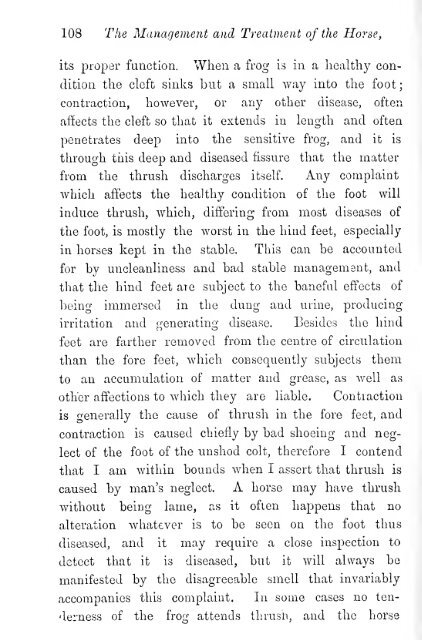The management and treatment of the horse in the stable, field, and ...
The management and treatment of the horse in the stable, field, and ...
The management and treatment of the horse in the stable, field, and ...
You also want an ePaper? Increase the reach of your titles
YUMPU automatically turns print PDFs into web optimized ePapers that Google loves.
108 <strong>The</strong> Management <strong>and</strong> Treatment <strong>of</strong> <strong>the</strong> Horse,<br />
its proper function. When a frog is <strong>in</strong> a healthy con-<br />
dition <strong>the</strong> cleft s<strong>in</strong>ks but a small way <strong>in</strong>to <strong>the</strong> foot<br />
contraction, however, or any o<strong>the</strong>r disease, <strong>of</strong>ten<br />
affects <strong>the</strong> cleft so that it extends <strong>in</strong> length <strong>and</strong> <strong>of</strong>ten<br />
penetrates deep <strong>in</strong>to <strong>the</strong> sensitive frog, <strong>and</strong> it is<br />
through this deep <strong>and</strong> diseased fissure that <strong>the</strong> matter<br />
from <strong>the</strong> thrush discharges itself. Any compla<strong>in</strong>t<br />
which affects <strong>the</strong> healthy condition <strong>of</strong> <strong>the</strong> foot will<br />
<strong>in</strong>duce thrush, which, differ<strong>in</strong>g from most diseases <strong>of</strong><br />
<strong>the</strong> foot, is mostly <strong>the</strong> worst <strong>in</strong> <strong>the</strong> h<strong>in</strong>d feet, especially<br />
<strong>in</strong> <strong>horse</strong>s kept <strong>in</strong> <strong>the</strong> <strong>stable</strong>. This can be accounted<br />
for by uncleanl<strong>in</strong>ess <strong>and</strong> bad <strong>stable</strong> <strong>management</strong>, <strong>and</strong><br />
that <strong>the</strong> h<strong>in</strong>d feet aie subject to <strong>the</strong> baneful effects <strong>of</strong><br />
be<strong>in</strong>g immersed <strong>in</strong> <strong>the</strong> dung <strong>and</strong> ur<strong>in</strong>e, produc<strong>in</strong>g<br />
irritation <strong>and</strong> generat<strong>in</strong>g disease. Besides <strong>the</strong> h<strong>in</strong>d<br />
feet are far<strong>the</strong>r removed from <strong>the</strong> centre <strong>of</strong> circulation<br />
than <strong>the</strong> fore feet, which consequently subjects <strong>the</strong>m<br />
to an accumulation <strong>of</strong> matter <strong>and</strong> grease, as well as<br />
o<strong>the</strong>r affections to which <strong>the</strong>y are liable. Contraction<br />
is generally <strong>the</strong> cause <strong>of</strong> thrush <strong>in</strong> <strong>the</strong> fore feet, <strong>and</strong><br />
contraction is caused chiefly by bad shoe<strong>in</strong>g <strong>and</strong> neg-<br />
lect <strong>of</strong> <strong>the</strong> foot <strong>of</strong> <strong>the</strong> unshod colt, <strong>the</strong>refore I contend<br />
that I am with<strong>in</strong> bounds when I assert that thrush is<br />
caused by man's neglect. A <strong>horse</strong> may have thrush<br />
without be<strong>in</strong>g lame, as it <strong>of</strong>ten happens that no<br />
alteration whatever is to be seen on <strong>the</strong> foot thus<br />
diseased, <strong>and</strong> it may require a close <strong>in</strong>spection to<br />
detect that it is diseased, but it will always be<br />
manifested by <strong>the</strong> disagreeable smell that <strong>in</strong>variably<br />
accompanies this compla<strong>in</strong>t. In some cases no ten-<br />
derness <strong>of</strong> <strong>the</strong> frosj attends thrush, <strong>and</strong> <strong>the</strong> <strong>horse</strong>
















